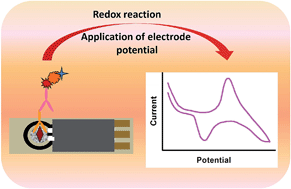Design and development of an amperometric immunosensor based on screen-printed electrodes†
Abstract
A novel disposable amperometric immunosensor has been developed based on laboratory fabricated screen-printed electrodes (SPEs) using an indirect enzyme linked immunosorbent assay (ELISA) approach. The electrodes were screen-printed on a non-tearable flexible polyester film using commercially available inks and characterized by cyclic voltammetry, scanning electron microscopy and X-ray diffraction. In order to study the immunosensing performances of these SPEs, bovine serum albumin (BSA) antigen was directly immobilized on the bare electrode surface without any surface modification. It was then exposed to primary antibody followed by horseradish peroxidase (HRP)-linked secondary antibody. 3,3′,5,5′-Tetramethylbenzidine (TMB) was used as the substrate. HRP oxidised TMB in the presence of hydrogen peroxide (H2O2) and the electron transfer was measured using amperometry at an applied scan rate of 50 mV s−1 which enabled the quantification of the antigen. The electrochemical response of this laboratory made SPE was about 2.5 times higher when compared to that of a commercially available SPE. A two-fold linear range for this immunosensor was obtained from 15.6–125 ng mL−1 and from 125–1000 ng mL−1, respectively.


 Please wait while we load your content...
Please wait while we load your content...